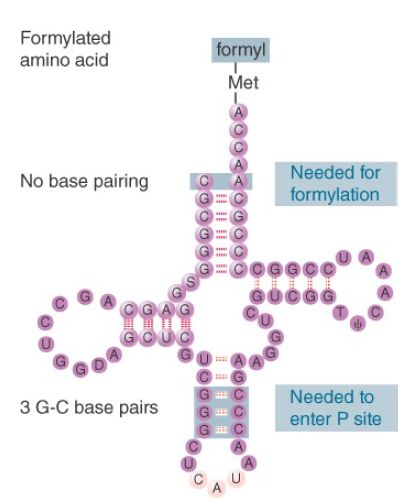


 النبات
النبات
 الحيوان
الحيوان
 الأحياء المجهرية
الأحياء المجهرية
 علم الأمراض
علم الأمراض
 التقانة الإحيائية
التقانة الإحيائية
 التقنية الحيوية المكروبية
التقنية الحيوية المكروبية
 التقنية الحياتية النانوية
التقنية الحياتية النانوية
 علم الأجنة
علم الأجنة
 الأحياء الجزيئي
الأحياء الجزيئي
 علم وظائف الأعضاء
علم وظائف الأعضاء
 الغدد
الغدد
 المضادات الحيوية
المضادات الحيوية|
Read More
Date: 14-11-2020
Date: 19-4-2021
Date: 19-5-2016
|
A Special Initiator tRNA Starts the Polypeptide Chain
KEY CONCEPTS
-Translation starts with a methionine amino acid usually encoded by AUG.
-Different methionine tRNAs are involved in initiation and elongation.
-The initiator tRNA has unique structural features thatdistinguish it from all other tRNAs.
- The amino group of the methionine bound to the bacterial initiator tRNA is formylated.
Synthesis of all polypeptides starts with the same amino acid—methionine. tRNAs recognizing the AUG codon carry methionine, and two types of tRNA can carry this amino acid. One is used for initiation, the other for recognizing AUG codons during elongation.
In bacteria, mitochondria, and chloroplasts, the initiator tRNA carries a methionine residue that has been formylated on its amino group, forming a molecule of N-formyl-methionyl-tRNA. The tRNA is known as tRNAf-Met. The name of the aminoacyl-tRNA is usually abbreviated to fMet-tRNAf .
The initiator tRNA gains its modified amino acid in a two-stage reaction. First, it is charged with the amino acid to generate MettRNA , and then the formylation reaction shown in Figure 1 blocks the free amino (–NH2 ) group. Although the blocked amino acid group would prevent the initiator from participating in chain elongation, it does not interfere with the ability to initiate a polypeptide.

FIGURE 1. The initiator N-formyl-methionyl-tRNA (fMet-tRNAf ) is generated by formylation of methionyl-tRNA using formyltetrahydrofolate as a cofactor.
This tRNA is used only for initiation. It recognizes the codons AUG or GUG (or occasionally UUG). The codons are not recognized equally well; the extent of initiation declines by about half when AUG is replaced by GUG, and declines by about half again when UUG is used.
The tRNA type responsible for recognizing only AUG codons following the initiation codon is tRNAmMet . Its methionine cannot be formylated.
What features distinguish the fMet-tRNAf initiator and the MettRNAm elongator? Some characteristic features of the tRNA sequence are important, as summarized in Figure 2. Some of these features are needed to prevent the initiator from being used in elongation, whereas others are necessary for it to function in initiation:
- Formylation is not strictly necessary because nonformylated Met-tRNAf can function as an initiator. However, formylation improves the efficiency with which the Met-tRNAf is used because it is one of the features recognized by IF-2, which binds the initiator tRNA.
- The bases that face one another at the last position of the stem to which the amino acid is connected are paired in all tRNAs except tRNAf Met . Mutations that create a base pair in this position of tRNAf Met allow it to function in elongation. Therefore, the absence of this pair is important in preventing tRNAf Met from being used in elongation. It is also needed for the formylation reaction.
- A series of three G-C pairs in the stem that precedes the loop containing the anticodon is unique to tRNAf Met . These base pairs are required to allow the fMet-tRNAf to be inserted directly into the P site.

FIGURE 22.15 fMet-tRNAf has unique features that distinguish it as the initiator tRNA.
In bacteria and mitochondria, the formyl residue on the initiator methionine is removed from the protein by a specific deformylase enzyme to generate a normal NH2 terminus. If methionine is to be the N-terminal amino acid of the protein, this is the only necessary step. In about half of the polypeptides, the methionine at the terminus is removed by an aminopeptidase, which creates a new terminus from R2 (originally the second amino acid incorporated into the chain). When both steps are necessary, they occur sequentially. The removal reaction(s) occur(s) rather rapidly when the nascent polypeptide chain has reached a length of about 15 amino acids.



|
|
|
|
لخفض ضغط الدم.. دراسة تحدد "تمارين مهمة"
|
|
|
|
|
|
|
طال انتظارها.. ميزة جديدة من "واتساب" تعزز الخصوصية
|
|
|
|
|
|
|
عوائل الشهداء: العتبة العباسية المقدسة سبّاقة في استذكار شهداء العراق عبر فعالياتها وأنشطتها المختلفة
|
|
|